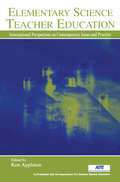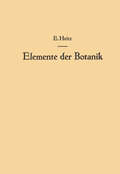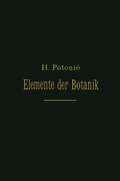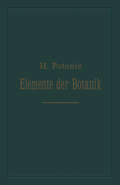- Table View
- List View
Elementary Processes in Excitations and Reactions on Solid Surfaces: Proceedings of the 18th Taniguchi Symposium Kashikojima, Japan, January 22–27, 1996 (Springer Series in Solid-State Sciences #121)
by Ayao Okiji Hideaki Kasai Kenji MakoshiElementary Processes in Excitations and Reactions on Solid Surfaces explores the fundamental nature of dynamics on solid surfaces. Attempts are made to reveal various aspects of elementary processes in excitations and reactions on solid surfaces by recent theoretical and experimental developments of the subjects such as molecular beams interacting with surfaces, ion beam scattering, laser-induced dynamical processes, electronically induced dynamical processes, and optical properties of solid surfaces. This volume is devided into three parts. Part I is concerned mainly with the rich reaction dynamics on potential-energy surfaces. Part II is devoted to the interplay of excitations. In Part III, new and rapidly developing methods are introduced.
Elementary Processes in Hydrogen-Helium Plasmas: Cross Sections and Reaction Rate Coefficients (Springer Series on Atomic, Optical, and Plasma Physics #4)
by Ratko K. Janev William D. Langer Kenneth Jr. Evans Douglass E. PostAtomic and molecular processes play an important role in laboratory and astrophysical plasmas for a wide range of conditions, and determine, in part, their electrical, transport, thermal, and radiation properties. The study of these and other plasma properties requires a knowledge of the cross sections, reaction rate coefficients, and inelastic energy transfers for a variety of collisional reactions. In this review, we provide quantitative information about the most important collision processes occurring in hy drogen, helium, and hydrogen-helium plasmas in the temperature range from 0. 1 eV to 20 keY. The material presented here is based on published atomic and molecular collision data, theoretical calculations, and appro priate extrapolation and interpolation procedures. This review gives the properties of each reaction, graphs of the cross sections and reaction rate coeffiCients, and the coefficients of analytical fits for these quantities. We present this information in a form that will enable researchers who are not experts in atomic physics to use the data easily. The authors thank their colleagues at the Princeton Plasma Physics Laboratory and in the atomic physics community who have made many useful suggestions for the selection and presentation o. f t. he material. We gratefully acknowledge the excellent technical assistance of Elizabeth Carey for the typing, and Bernie Giehl for the drafting. This work was supported in part by the U. S. Department of Energy Contract No. DE-AC02-76-CHO-3073. Princeton, USA R. K. Janev W. D. Langer September, 1987 K. Evans, Jr. , D. E.
Elementary Processes in Organic Photovoltaics (Advances in Polymer Science #272)
by Karl LeoThis volume presents the results of a multi-year research programme funded by the Deutsche Forschungsgemeinschaft (German Research Council), which explains how organic solar cells work. In this new promising photovoltaic technology, carbon-based materials are deposited by low-cost methods onto flexible substrates, thus allowing devices which open completely new applications like transparent coatings for building, solar cells integrated into clothing or packages, and many more. The investigation of organic solar cells is an interdisciplinary topic, covering physics, chemistry and engineering. The different chapters address topics ranging from the synthesis of new organic materials, to the characterization of the elementary processes such as exciton transport and separation, and the principles of highly efficient device design.
Elementary Reaction Steps in Heterogeneous Catalysis (Nato Science Series C: #398)
by R. W. Joyner R. A. Van SantenThis book comprises the proceedings of a NATO sponsored Advanced Research Workshop held from 1st November to 6th November 1992 in the delightful Chateau de Florans, Bedoin, Vaucluse, France and entitled 'Elementary Reaction Steps in Heterogeneous Catalysis. ' The organisers are grateful to the Science Committee of NATO for their support of this meeting. This is believed to be the first wide ranging NATO ARW in the field of heterogeneous catalysis for 20 years, following a previous venture organised in Sardinia by Basolo and Burwell, of Northwestern University, Illinois, USA [1]. This volume collects the lecture presentations and reports on the lively Panel discussions. The idea for the meeting evolved from a series of International Symposia on Quantum Chemistry and Mechanism in Heterogeneous Catalysis. The first of these was held in Lyon, France in 1986, the second in Krakow, Poland in 1988 and the third in Berkeley, California in 1990. The organising committee of the present meeting was Bernard Bigot, France, Tony Farragher, Netherlands, Richard Joyner, UK, Mme. Danielle Olivier, France, and Rutger van Santen, Netherlands, (Chairman). We wish to thank all members of the committee but in particular Bernard Bigot, who undertook the very extensive work involved in the local organisation with consummate skill and made our stay in Provence a great pleasure. Bernard Bigot's secretary, Mme. Marie-Noelle Coscat and Richard Joyner's secretary, Mrs. Pat Gibbs, also deserve our considerable thanks. There were fifty-four participants from eleven countries.
Elementary Science Teacher Education: International Perspectives on Contemporary Issues and Practice
by Ken AppletonCo-Published with the Association For Science Teacher Education. Reflecting recent policy and standards initiatives, emerging research agendas, and key innovations, this volume provides a contemporary overview of important developments and issues that have that have in recent years shaped elementary science education pre-service courses and professional development, and practices that are shaping future directions in the field. Contributors from several countries who are actively engaged in research and design in elementary science education address:*Conceptual issues which impinge on contemporary science teacher education;*Intersections of content, pedagogy, and practice; and*Professional development as a contextualized practice.Elementary Science Teacher Education: International Perspectives on Contemporary Issues and Practice offers a clear picture of the current state of the field and directions for the future--to the benefit of elementary science teacher educators, aspiring teacher educators, school policy makers, other professionals involved in science education and, ultimately, the millions of elementary school children who will gain from improved practice.
Elementary Science Teacher Education: International Perspectives on Contemporary Issues and Practice
by Ken AppletonCo-Published with the Association For Science Teacher Education. Reflecting recent policy and standards initiatives, emerging research agendas, and key innovations, this volume provides a contemporary overview of important developments and issues that have that have in recent years shaped elementary science education pre-service courses and professional development, and practices that are shaping future directions in the field. Contributors from several countries who are actively engaged in research and design in elementary science education address:*Conceptual issues which impinge on contemporary science teacher education;*Intersections of content, pedagogy, and practice; and*Professional development as a contextualized practice.Elementary Science Teacher Education: International Perspectives on Contemporary Issues and Practice offers a clear picture of the current state of the field and directions for the future--to the benefit of elementary science teacher educators, aspiring teacher educators, school policy makers, other professionals involved in science education and, ultimately, the millions of elementary school children who will gain from improved practice.
Elementary Statistical Methods
by G. WetherillThis book is mainly based on lectures given by Professor D. R. Cox and myself at Birkbeck College over a period of eight to nine years. It began as a. joint venture, but pressure of other work made it necessary for Professor Cox to withdraw early on. I have throughout received much valuable advice and encouragement from Professor Cox, but of course, I am solely responsible for the text, and any errors remaining in it. The book is intended as a first course on statistical methods, and there is a liberal supply of exercises. Although the mathematical level of the book is low, I have tried to explain carefully the logical reasoning behind the use of the methods discussed. Some of the exercises which require more difficult mathematics are marked with an asterisk, and these may be omitted. In this way, I hope that the book will satisfy the needs for a course on statistical methods at a range of mathematical levels. It is essential for the reader to work through the numerical exercises, for only in this way can he grasp the full meaning and usefulness of the statistical techniques, and gain practice in the interpretation of the results. Chapters 7 and 8 discuss methods appropriate for use on ranked or discrete data, and Chapters 9-12 do not depend on these chapters. Chapters 7 and 8 may therefore be omitted, if desired.
Elementary Statistical Thermodynamics: A Problems Approach
by N.O. SmithThis book is a sequel to my Chemical Thermodynamics: A Prob lems Approach published in 1967, which concerned classical thermodynamics almost exclusively. Most books on statistical thermodynamics now available are written either for the superior general chemistry student or for the specialist. The author has felt the need for a text which would bring the intermediate reader to the point where he could not only appreciate the roots of the subject but also have some facility in calculating thermodynamic quantities. Although statistical thermodynamics comprises an essential part of the college training of a chemist, its treatment in general physical chem istry texts is, of necessity, compressed to the point where the less competent student is unable to appreciate or comprehend its logic and beauty, and is reduced to memorizing a series of formulas. It has been my aim to fill this need by writing a logical account of the foundations and applications of the sub ject at a level which can be grasped by an undergraduate who has had some exposure to calculus and to the basic concepts of classical thermodynamics. It can serve as a text or supple mentary reading for a course, or provide the means whereby one could become conversant with the subject on his own, without the benefit of an instructor.
Elemente der Achten Hauptgruppe: Edelgase: Helium · Neon · Argon · Krypton · Xenon · Radon und Isotope (Handbuch der analytischen Chemie Handbook of Analytical Chemistry #3 / 8 / 8a / 8a)
by H. KahleElemente der Achten Hauptgruppe: Edelgase: Helium · Neon · Argon · Krypton · Xenon · Radon und Isotope (Handbuch der analytischen Chemie Handbook of Analytical Chemistry #8a)
by Heinrich Kahle Berta KarlikElemente der achten Nebengruppe: III Platinmetalle Platin Palladium · Rhodium · Iridium Ruthenium · Osmium (Handbuch der analytischen Chemie Handbook of Analytical Chemistry)
by Georg Bauer Wilhelm Fresenius Wilhelm Geibel Gerhart Jander Hans OberländerElemente der Achten Nebengruppe: Platinmetalle Platin · Palladium · Rhodium · Iridium Ruthenium · Osmium (Handbuch der analytischen Chemie Handbook of Analytical Chemistry #8bβ)
by Georg Bauer Konrad RuthardtElemente der Achten Nebengruppe: Eisen · Kobalt · Nickel (Handbuch der analytischen Chemie Handbook of Analytical Chemistry)
by Barbara Grüttner Wilhelm Fresenius H. Hahn Gerhart JanderElemente der Achten Nebengruppe I: Eisen · Kobalt · Nickel (Handbuch der analytischen Chemie Handbook of Analytical Chemistry #2 / 8 / B / 8b a)
by Barbara Grüttner H. HahnElemente der Achten Nebengruppe II: Platinmetalle (Handbuch der analytischen Chemie Handbook of Analytical Chemistry #8)
by Georg Bauer Konrad RuthardtElemente der Botanik: Eine Anleitung zum Studium der Pflanze durch Beobachtungen und Versuche an Crepis capillaris <L.> Wallr.
by Emil HeitzElemente der Chemie-Ingenieur-Technik: Wissenschaftliche Grundlagen und Arbeitsvorgänge der chemisch-technologischen Apparaturen
by Walther L. Badger Warren L. McCabe NA KutznerDieser Buchtitel ist Teil des Digitalisierungsprojekts Springer Book Archives mit Publikationen, die seit den Anfängen des Verlags von 1842 erschienen sind. Der Verlag stellt mit diesem Archiv Quellen für die historische wie auch die disziplingeschichtliche Forschung zur Verfügung, die jeweils im historischen Kontext betrachtet werden müssen. Dieser Titel erschien in der Zeit vor 1945 und wird daher in seiner zeittypischen politisch-ideologischen Ausrichtung vom Verlag nicht beworben.
Elemente der Dritten Gruppe: Bor · Aluminium · Gallium · Indium · Thallium · Scandium · Yttrium · Elemente der Seltenen Erden Lanthan—Cassiopeium Actinium und Mesothor 2 (Handbuch der analytischen Chemie Handbook of Analytical Chemistry)
by A. Brukl O. Erbacher A. Faessler H. Fischer F. Kurz K. Lang G. Rienäcker A. v. Unruh E. WibergDieser Buchtitel ist Teil des Digitalisierungsprojekts Springer Book Archives mit Publikationen, die seit den Anfängen des Verlags von 1842 erschienen sind. Der Verlag stellt mit diesem Archiv Quellen für die historische wie auch die disziplingeschichtliche Forschung zur Verfügung, die jeweils im historischen Kontext betrachtet werden müssen. Dieser Titel erschien in der Zeit vor 1945 und wird daher in seiner zeittypischen politisch-ideologischen Ausrichtung vom Verlag nicht beworben.
Elemente der Dritten Gruppe: Bor · Aluminium · Gallium · Indium · Thallium · Scandium · Yttrium · Elemente der Seltenen Erden (Lanthan bis Cassiopeium) · Actinium (Handbuch der analytischen Chemie Handbook of Analytical Chemistry #3)
by R. Fresenius G. JanderDieser Buchtitel ist Teil des Digitalisierungsprojekts Springer Book Archives mit Publikationen, die seit den Anfängen des Verlags von 1842 erschienen sind. Der Verlag stellt mit diesem Archiv Quellen für die historische wie auch die disziplingeschichtliche Forschung zur Verfügung, die jeweils im historischen Kontext betrachtet werden müssen. Dieser Titel erschien in der Zeit vor 1945 und wird daher in seiner zeittypischen politisch-ideologischen Ausrichtung vom Verlag nicht beworben.
Elemente der Dritten Hauptgruppe Bor (Handbuch der analytischen Chemie Handbook of Analytical Chemistry #3 / 3 / 3a / 3a a / a1)
by Gerold Wünsch F. UmlandElemente der Dritten Hauptgruppe Teil II und der Dritten Nebengruppe: Gallium · Indium · Thallium · Scandium Yttrium · Elemente der Seltenen Erden (Lanthan-Cassiopeium) · Actinium und Mesothor 2 Actinium und Isotope (Handbuch der analytischen Chemie Handbook of Analytical Chemistry #3 / 3 / 3a / 3a b/3b)
by A. BruklElemente der dritten Hauptgruppe Teil II und der dritten Nebengruppe: Gallium · Indium · Thallium · Scandium yttrium · Elemente der Seltenen Erden (Lanthan-Cassiopeium) · Actinium und Mesothor 2 Actinium und Isotope (Handbuch der analytischen Chemie Handbook of Analytical Chemistry #3aβ/3b)
by Alfred BruklElemente der Ersten Hauptgruppe: Lithium · Natrium · Kalium · Ammonium · Rubidium · Caesium (Handbuch der analytischen Chemie Handbook of Analytical Chemistry #3 / 1 / 1a)
by E. Brennecke F. Busch L. Fresenius R. FreseniusDieser Buchtitel ist Teil des Digitalisierungsprojekts Springer Book Archives mit Publikationen, die seit den Anfängen des Verlags von 1842 erschienen sind. Der Verlag stellt mit diesem Archiv Quellen für die historische wie auch die disziplingeschichtliche Forschung zur Verfügung, die jeweils im historischen Kontext betrachtet werden müssen. Dieser Titel erschien in der Zeit vor 1945 und wird daher in seiner zeittypischen politisch-ideologischen Ausrichtung vom Verlag nicht beworben.























